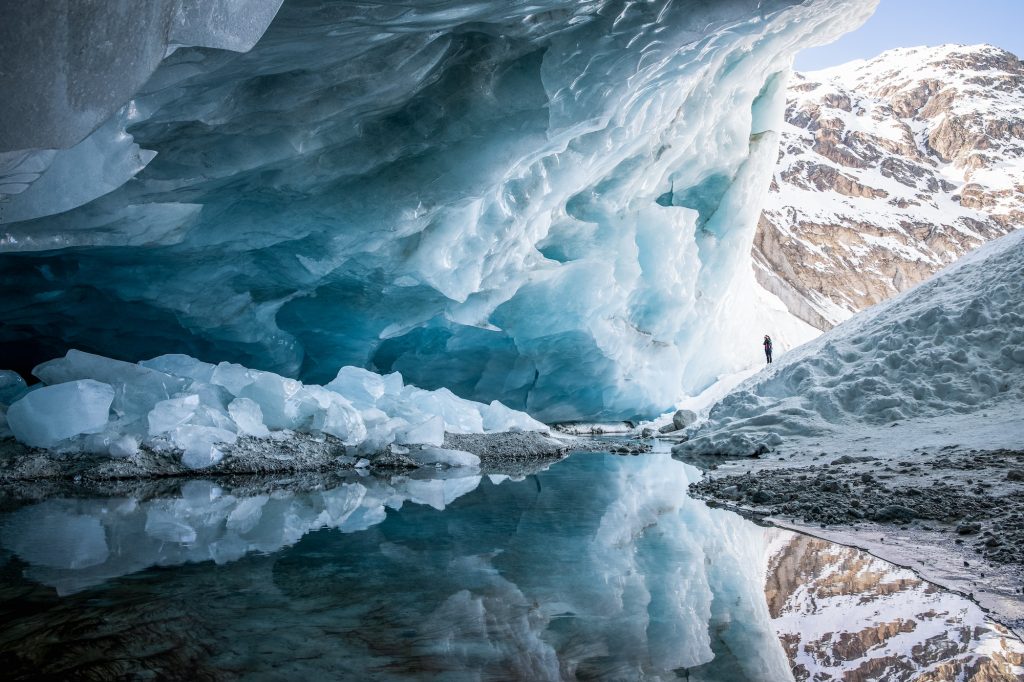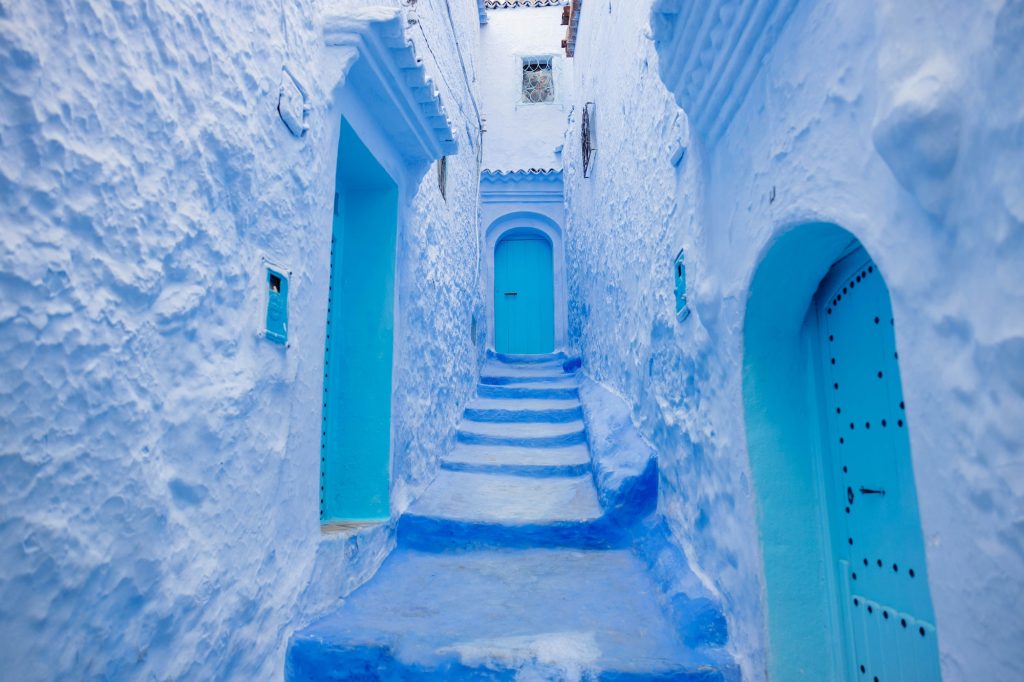with
Learn more
The Awe Effect
Neuroscience now supports what travellers have long felt: being in the presence of great beauty can be transformational.
“When I think of beauty, I also think of beautiful landscapes that I know,” said the Irish poet John O’Donohue. I feel this in my bones. The most meaningful moments of my life have taken place outside—in wilderness, in the presence of something so large it made me feel small. Boating down the Ganges in Varanasi. Walking a suspension bridge high above the jungle in Costa Rica. Staring into a midnight bay in the San Juan Islands and watching creatures bloom bioluminescent beneath the black water. Sitting on a heap of rag rugs on a rooftop beneath the blazing sun in Chefchaouen, Morocco, with a cup of hot mint tea in hand.
I guess you could say I was in awe.

The word awe has roots in Old English: ege—fear, dread, terror. Go deeper and you land in Old Norse: agi. Same meaning, only more intense. The kind of fright that makes your stomach drop and your skin hum. Awe once meant trembling before something vast and unknowable. Awe had nothing to do with fumbling in your pocket for your phone to snap a selfie, to prove to other people you’d been to a place and been moved by it. It was about standing still, overcome by the magnificence of the world, your brain sizzling with majesty. It was about being afraid—in a good way—of how big the universe is. It was about bowing down. The experience of awe was an embodied one. Reverence and surrender, a mystery inside your bones.
By the time of Middle English, the idea of awe had evolved into something more attainable—the tender recognition of quiet beauty everywhere. A perfect rainbow after a storm. A temple where your breath echoes. At the edge of a birth, a death, or a galaxy too big to name. One could even find awe in the tiny, mundane moments or minutiae of the natural world—a rose petal, a frozen pond. Vastness veined with grace. As Walt Whitman wrote in Song of Myself, “I believe a leaf of grass is no less than the journeywork of the stars.”

Now neuroscience is catching up to what mystics, poets, and travellers have always known: Awe rewires us. According to Dacher Keltner, a professor of psychology at University of California, Berkeley, awe is not a luxury—it’s a biological necessity. Defined by Keltner as “the feeling of being in the presence of something vast that transcends your current understanding of the world,” awe has measurable effects on the body and brain. A 2015 study co-authored by Keltner revealed that participants who felt positive emotions, such as awe, wonder, and amazement, had lower levels of the cytokine interleukin-6, a marker for inflammation. And Keltner’s research also has found that experiencing awe can trigger the release of oxytocin, the bonding hormone, which has been shown to decrease anxiety levels.
In his book Awe: The New Science of Everyday Wonder and How It Can Transform Your Life, Keltner identified “eight wonders of life”: nature, the moral beauty of others, collective movement (shared joy in groups), music, visual design, spirituality, big ideas, and, as he puts it, “encountering the beginning and end of life.” These are the stimuli that pull us into the present, that return us to the why.

And it gets more interesting. In Soft-Wired: How the New Science of Brain Plasticity Can Change Your Life, neuroscientist Dr. Michael Merzenich says that to stay sharp and healthy as we age, we need the unfamiliar. We need to jolt the system.
Travel does that, scrambling the senses in the best way. A new language in your ear. Smoke and spice in your nose. A cerulean sky, deep and rich as the ocean. When exposed to new stimuli, the brain forms new neural pathways. According to Merzenich, novelty keeps the brain lit up. People who stay curious don’t just age; they grow. “This lifelong capacity for plasticity, for brain change, is powerfully expressed. It is the basis of our real differentiation, one individual from another,” he said.
For me, simply navigating a foreign grocery store—figuring out which fruit is which or translating a label—is a way of triggering brain activity. And curiosity itself is neurologically rewarding. When you explore something new, your brain’s reward system is activated, releasing dopamine, its built-in pleasure chemical. The stronger the dopamine response, the stronger the reinforcement signal, making us more likely to repeat the behaviour. The more you explore, the more you want to explore. Wonder can become a feedback loop. And we need that loop now more than ever.

The goal is to put down your phone and feel what it’s like to be in the presence of great beauty—to metabolize your own relationship to the divine in real time.
More and more of us are seeking “mental wellness.” We’re booking getaways not to check out but to check back in. We’re exhausted, depleted from hyper-productivity and hyper-connectivity. We want the reset. Yet nearly 72 percent of global travellers use social media while on vacation, according to a study out this year. Many now use AI to plan, curate, and narrate the experience before it’s even begun. We consult influencers before we consult the wind.
We’ve turned awe into content—and risked missing it altogether. The goal is to put down your phone and feel what it’s like to be in the presence of great beauty—to metabolize your own relationship to the divine in real time. To be humbled by it all and do nothing but breathe. No stories. No likes. No selfies.
In my travels, I’ve learned that awe must be experienced firsthand. It reveals itself in the most beautiful places on Earth, such as the Sea of Stars on Vaadhoo Island in the Maldives, where the waves glow turquoise and footsteps spark light across the beach. The Banyumala Twin Waterfalls, in Bali, cascading through thick jungle. The glacial caves of Aletsch and Zinal in Switzerland—frozen, echoing, otherworldly. The Byodo-In Temple near Kyoto, still and ancient. These places carry a sacred frequency.
Awe doesn’t always announce itself. This past winter, standing barefoot on Playa Majahua, a secluded beach on the Pacific Coast of Jalisco, near Four Seasons Resort Tamarindo, Mexico, I felt something inside of me shift. It was sunrise. The moon was sliding down the sky as the sun rose. The air was balmy and fragrant with cypress and gardenia. There was a puma print pressed into the cool, smooth sand. For a moment, it felt like the whole world was holding its breath.
More like this
bars jakarta
What to Do in Jakarta: A Furniture Designer Gives a Tour of His Hometown
Alvin Tjitrowirjo, a champion of sustainable materials, recommends hidden gems in the bustling megacity.
adventure travel
The Awe Effect
Neuroscience now supports what travellers have long felt: being in the presence of great beauty can be transformational.
Trending
-
Milan’s Global Moment
As Italy’s design capital prepares to cohost the 2026 Winter Olympics, a surge of international creatives is redefining the city’s cultural pulse.
-
Bring The Four Seasons
Experience HomeRest peacefully on the world’s most comfortable mattress.
-
Opinion: In Defence of Luck
In the success equation, luck plays an important role.



